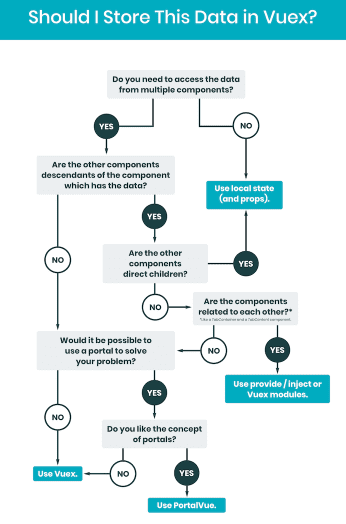Navigating State Management in Vue.js: When and Why to Use Vuex
Introduction
When delving into the realm of Vuex, a common dilemma arises among developers – what data should be stored in Vuex? The initial inclination often leads to the “Let’s Store Everything in Vuex” phase, only to be met with the realization that this approach might not be the panacea for state management in Vue.js applications. This article aims to provide a comprehensive exploration of when Vuex is a fitting solution and when alternative approaches may be more appropriate.
1. Understanding Vuex Integration
Out of the box, Vue.js offers a robust mechanism for handling state through reactive data properties and the ability to pass properties to child components. For simpler applications or those incorporating Vue.js as a supplementary magic touch, Vuex may not be necessary.
javascript
export default {
name: 'MyComponent',
data() {
return {
someValue: 'Hello World',
};
},
}
2. When to Use Vuex
For large-scale single-page applications, scenarios may arise where the same data is needed in disparate sections of the application. This is where Vuex, as a centralized state management tool, proves advantageous.
Reasons for Storing Data in Vuex
2.1 Data Accessibility Across Components
The primary use case for Vuex is when data needs to be accessed by multiple independent components, not directly related to each other. Examples include user settings that configure the application’s appearance or date format.
2.2 Centralized API/Data Fetching Logic
In intricate applications, such as a To-Do app with varied categories, Vuex allows fetching data once and accessing it across components distributed across different routes.
2.3 Persisting Application State
Vue.js plugins like vuex-persistedstate facilitate easy state persistence in the browser, enabling advanced use cases, including offline functionality.
3. Reasons Not to Store Data in Vuex
Once committed to using Vuex for state management, every new component prompts a decision on whether to store its state in Vuex. However, it’s crucial to acknowledge situations where Vuex may not be the optimal solution.
Downsides of Using Vuex
3.1 Complexity
While simpler than some alternatives, Vuex introduces additional complexity compared to managing local component state directly. Evaluate if the benefits of centralized state management justify this complexity.
3.2 Overhead
Using Vuex in a component introduces architectural overhead. Default to local component state and opt for Vuex only when specific reasons arise.
4. Alternatives to Vuex
In scenarios where Vuex might not be the optimal solution, several alternatives exist, each tailored to specific use cases.
4.1 Passing Down Props
The simplest solution is often the best. If passing data from a parent to a child component via props is feasible, it is a recommended approach.
4.2 Provide/Inject
Vue.js provides the less-known provide/inject feature, useful for passing data from a parent component to one or more child components not directly descended from the parent.
4.3 Context Provider Pattern
Vue 3 introduces an upgraded Provide/Inject mechanism, allowing the creation of Context Providers, enabling state sharing between components without the overhead of Vuex.
4.4 Simple Vuex Alternative: Pinia
For those seeking a lightweight global state management solution, Pinia serves as a capable and less heavyweight alternative to Vuex.
4.5 Caching Server-Side Data
Utilizing Apollo or swrv, developers can implement caching mechanisms for server-side data, enhancing performance and reducing unnecessary API calls.
4.6 Portals
PortalVue, seemingly unrelated to state management, can offer direct access to a component’s state in certain situations, providing an alternative to centralized stores.
4.7 GraphQL & Apollo
For applications already leveraging GraphQL and Apollo, utilizing the local state feature of Apollo can serve as a viable option for state management.
5. Decision Flow Chart
To facilitate decision-making on whether to store data in Vuex, a flow chart provides a structured approach to evaluating the necessity of centralized state management.

Vuex
Conclusion
In the diverse landscape of software development, there is no one-size-fits-all solution. Situational awareness is key, and while some techniques may excel in specific contexts, they might not universally apply. Embrace a mindset open to exploring both new and established approaches, recognizing that the learning process is iterative, and code can always be refactored for improvement.